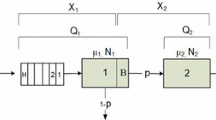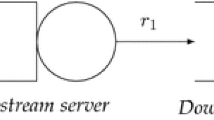Abstract
A two-station, four-class queueing network with dynamic scheduling of servers is analyzed. It is shown that the corresponding Markov decision problem converges under fluid scaling to a fluid optimal control model. The structure of the optimal policy for the fluid network, and of an asymptotically optimal policy for the queueing network are derived in an explicit form. They concur with the tandem μ-rule, if this policy gives priority to the same flow of customers in both stations. In general, they are monotone with a linear switching surface.
Similar content being viewed by others
References
D. Atkins and H. Chen, Performance evaluation of scheduling control of queueing network: Fluid model heuristics, Queueing Systems 21 (1995) 391–413.
F. Avram, D. Bertsimas and M. Ricard, Fluid models of sequencing problems in open queueing networks: An optimal control approach, in: Stochastic Networks, eds. F. Kelly and R. Williams, IMA Volumes in Mathematics and its Applications, Vol. 71 (Springer, New York, 1995) pp. 199–234.
N. Bäuerle and U. Rieder, Optimal control of single-server fluid networks, Queueing Systems 35 (2000) 185–200 (this volume).
H. Chen and A. Mandelbaum, Discrete flow networks: Bottlenecks analysis and fluid approximations, Math. Oper. Res. 16(2) (1991) 408–446.
H. Chen and D. Yao, Dynamic scheduling of a multiclass fluid networks, Oper. Res. 41(6) (1993) 1104–1115.
D. Eng, J. Humphrey and S.P. Meyn, Fluid network models: Linear programs for control and performance bounds, in: 13th World Congress of International Federation of Automatic Control, San Francisco (1996).
A. Gajrat, A. Hordijk, V. Malyshev and F. Spieksma, Fluid approximations of Markov decision chains, Markov Process. Related Fields 3 (1997) 129–150.
T.C. Green and S. Stidham, Sample-path conservation laws, with applications to scheduling queues and fluid systems, Technical Report (1999).
P.J. Holewijn and A. Hordijk, On the convergence of moments in stationary Markov chains, Stochastic Process. Appl. 3 (1975) 55–64.
A. Hordijk, Dynamic programming and its applications, Math. Center Tract. 51 (1974).
A. Hordijk and G. Koole, On the optimality of LEPT and μc rules for parallel processors and dependent arrival processes, Adv. in Appl. Probab. 25 (1993) 979–996.
A. Hordijk and G. Koole, On suboptimal policies in multiclass tandem models, Probab. Engrg. Inform. Sci. 10 (1996) 29–39.
I.K. Kleinrock, Queueing systems, Vol. 2: Computer Applications (1976).
C. Maglaras, Discrete-review policies for scheduling stochastic networks: Fluid scale asymptotic optimality, submitted to Ann. Appl. Probab. (1997).
S.P. Meyn, Stability and optimization of queueing networks and their fluid models, in: Proc. of the Summer Seminar on The Mathematics of Stochastic Manufacturing Systems, Williamsburg, VA (June 17–21, 1996).
S.P. Meyn, The policy improvement algorithm for Markov decision processes with general state space, IEEE Trans. Automat. Control (December 1997).
J.A. van Mieghem, Dynamic scheduling with convex delay costs: The generalized cμ rule, Ann. Appl. Probab. 5(3) (1995) 808–833.
L.S. Pontryagin, V.G. Boltyanskii, R.V. Gamkrelidze and E.F. Mishenko, The Mathematical Theory of Optimal Processes (Pergamon, Oxford, 1964).
M.C. Pullan, A duality theory for separated continuous linear programs, SIAM J. Control Optim. 34(3) (1996) 931–965.
M.L. Puterman, Markov Decision Process (Wiley, New York, 1994).
H.L. Royden, Real Analysis, 2nd ed. (Collier-Mcmillan Limited, London, 1968).
A.N. Rybko and A.L. Stolyar, Ergodicity of stochastic processes describing the operations of open queueing networks, Problems Inform. Transmission 28 (1992) 199–220.
A. Seierstad and K. Sydsæter, Sufficient conditions in optimal control theory, Internat. Econom. Rev. 18(2) (1977) 367–391.
A. Seierstad and K. Sydsæter, Optimal Control Theory With Economic Applications (North-Holland, Amsterdam, 1987).
G. Weiss, Algorithm for minimum wait draining of two station fluid re-entrant line, to appear in Ann. Oper. Res.
Author information
Authors and Affiliations
Rights and permissions
About this article
Cite this article
Gajrat, A., Hordijk, A. Fluid approximation of a controlled multiclass tandem network. Queueing Systems 35, 349–380 (2000). https://doi.org/10.1023/A:1019162615537
Issue Date:
DOI: https://doi.org/10.1023/A:1019162615537




